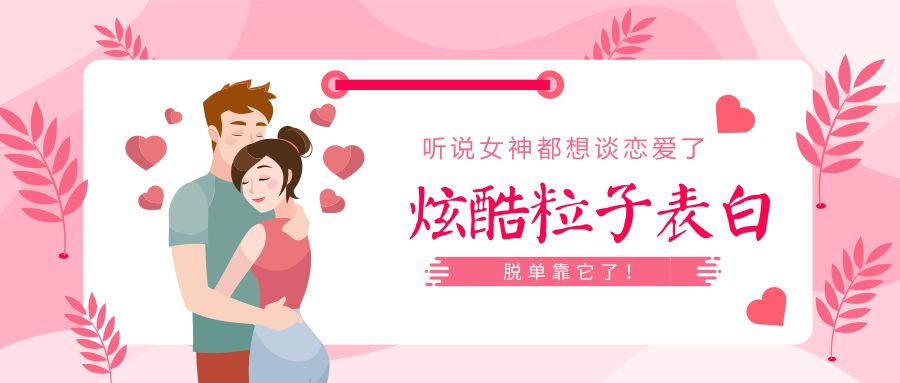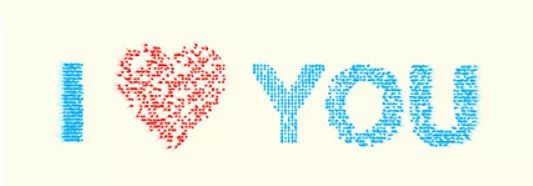炫酷粒子表白 | 聽說女神都想談戀愛了!
阿新 • • 發佈:2018-12-11

最近聽女神說想談戀愛了,✧(≖ ◡ ≖) 嘿嘿,一定不能放過這個機會,給她來個不一樣的表白。
那麼咱們就一起來把這個粒子系統玩出花來吧
演示地址:
https://es2049.studio/work-show/textPraticle/
如何將一系列的粒子組成一句表白呢?

實現原理其實很簡單,Canvas 中有個 getImageData 的方法,可以得到一個矩形範圍所有畫素點資料。那麼我們就試試來獲取一個文字的形狀吧。
第一步,用 measureText 的方法來計算出文字適當的尺寸和位置。
// 建立一個跟畫布等比例的 canvas const width = 100; const height = ~~(width * this.height / this.width); // this.width , this.height 說整個畫布的尺寸 const offscreenCanvas =document.createElement('canvas'); const offscreenCanvasCtx =offscreenCanvas.getContext('2d'); offscreenCanvas.setAttribute('width', width); offscreenCanvas.setAttribute('height', height); // 在這離屏 canvas 中將我們想要的文字 textAll 繪製出來後,再計算它合適的尺寸 offscreenCanvasCtx.fillStyle = '#000'; offscreenCanvasCtx.font = 'bold 10px Arial'; constmeasure=offscreenCanvasCtx.measureText(textAll); // 測量文字,用來獲取寬度 const size = 0.8; // 寬高分別達到螢幕0.8時的size const fSize=Math.min(height * size * 10 / lineHeight, width * size * 10 / measure.width); // 10畫素字型行高 lineHeight=7 magic offscreenCanvasCtx.font = `bold ${fSize}px Arial`; // 根據計算後的字型大小,在將文字擺放到適合的位置,文字的座標起始位置在左下方 const measureResize =offscreenCanvasCtx.measureText(textAll); // 文字起始位置在左下方 let left = (width - measureResize.width) / 2; const bottom=(height + fSize / 10 * lineHeight) / 2; offscreenCanvasCtx.fillText(textAll, left, bottom);
咱們可以 appendChild 到 body 裡看眼

同學們注意,我要開始變形了 [推眼鏡] 。 getImageData 獲取的畫素資料是一個 Uint8ClampedArray (值是 0 - 255 的陣列),4 個數一組分別對應一個畫素點的 R G B A 值。我們只需要判斷 i * 4 + 3 不為 0 就可以得到需要的字型形狀資料了。
// texts 所有的單詞分別獲取 data ,上文的 textAll 是 texts 加一起 Object.values(texts).forEach(item => { offscreenCanvasCtx.clearRect(0, 0, width, height); offscreenCanvasCtx.fillText(item.text, left, bottom); left += offscreenCanvasCtx.measureText(item.text).width; const data = offscreenCanvasCtx.getImageData(0, 0, width, height); const points = []; // 判斷第 i * 4 + 3 位是否為0,獲得相對的 x,y 座標(使用時需乘畫布的實際長寬, y 座標也需要取反向) for (let i = 0, max = data.width * data.height; i < max; i++) { if (data.data[i * 4 + 3]) { points.push({ x: (i % data.width) / data.width, y: (i / data.width) / data.height }); } } // 儲存到一個物件,用於後面的繪製 geometry.push({ color: item.hsla, points }); })
制定場景,繪製圖形
文字圖形的獲取方式以及搞定了,那麼咱們就可以把內容整體輸出了。咱們定義一個簡單的指令碼格式。
// hsla 格式方便以後做色彩變化的擴充套件 const color1 = {h:197,s:'100%',l:'50%',a:'80%'}; const color2 = {h:197,s:'100%',l:'50%',a:'80%'}; // lifeTime 禎數 const Actions = [ {lifeTime:60,text:[{text:3,hsla:color1}]}, {lifeTime:60,text:[{text:2,hsla:color1}]}, {lifeTime:60,text:[{text:1,hsla:color1}], {lifeTime:120,text:[ {text:'I',hsla:color1}, {text:'❤️',hsla:color2}, {text:'Y',hsla:color1}, {text:'O',hsla:color1}, {text:'U',hsla:color1} ]}, ];
根據預設的指令碼解析出每個場景的圖形,加一個 tick 判斷是否到了 lifeTime 切換到下一個圖形重新繪製圖形。
function draw() {
this.tick++;
if (this.tick >= this.actions[this.actionIndex].lifeTime) {
this.nextAction();
}
this.clear();
this.renderParticles(); // 繪製點
this.raf = requestAnimationFrame(this.draw);
}
function nextAction() {
....//切換場景 balabala..
this.setParticle(); // 隨機將點設定到之前得到的 action.geometry.points 上
}
這樣咱們基本的功能已經完成了。
能不能再給力一點
說好的粒子系統,現在只是 context.arc 簡單的畫了一點。那咱們就來加個粒子系統吧。
class PARTICLE {
// x,y,z 為當前的座標,vx,vy,vz 則是3個方向的速度
constructor(center) {
this.center = center;
this.x = 0;
this.y = 0;
this.z = 0;
this.vx = 0;
this.vy = 0;
this.vz = 0;
}
// 設定這些粒子需要運動到的終點(下一個位置)
setAxis(axis) {
this.nextX = axis.x;
this.nextY = axis.y;
this.nextZ = axis.z;
this.color = axis.color;
}
step() {
// 彈力模型 距離目標越遠速度越快
this.vx += (this.nextX - this.x) * SPRING;
this.vy += (this.nextY - this.y) * SPRING;
this.vz += (this.nextZ - this.z) * SPRING;
// 摩擦係數 讓粒子可以趨向穩定
this.vx *= FRICTION;
this.vy *= FRICTION;
this.vz *= FRICTION;
this.x += this.vx;
this.y += this.vy;
this.z += this.vz;
}
getAxis2D() {
this.step();
// 3D 座標下的 2D 偏移,暫且只考慮位置,不考慮大小變化
const scale = FOCUS_POSITION / (FOCUS_POSITION + this.z);
return {
x: this.center.x + (this.x * scale),
y: this.center.y - (this.y * scale),
};
}
}
大功告成!
既然是 3D 的粒子,其實這上面還有不是文章可做,同學們可以發揮想象力來點更酷炫的。
還有什麼好玩的
上面是將粒子擺成文字。那咱們當然也可以直接寫公式擺出個造型。
// Actions 中用 func 代替 texts
{
lifeTime: 100,
func: (radius) => {
const i = Math.random() * 1200;
let x = (i - 1200 / 2) / 300;
let y = Math.sqrt(Math.abs(x)) - Math.sqrt(Math.cos(x)) * Math.cos(30 * x);
return {
x: x * radius / 2,
y: y * radius / 2,
z: ~~(Math.random() * 30),
color: color3
};
}
}
再把剛才文字轉換形狀的方法用一下
{
lifeTime: Infinity,
func: (width, height) => {
if(!points.length){
const img = document.getElementById("tulip");
constoffscreenCanvas = document.createElement('canvas');
constoffscreenCanvasCtx = offscreenCanvas.getContext('2d');
const imgWidth = 200;
const imgHeight = 200;
offscreenCanvas.setAttribute('width', imgWidth);
offscreenCanvas.setAttribute('height', imgHeight);
offscreenCanvasCtx.drawImage( img, 0, 0, imgWidth, imgHeight);
let imgData=offscreenCanvasCtx.getImageData( 0, 0, imgWidth, imgHeight);
for ( let i = 0, max = imgData.width * imgData.height; i < max; i++) {
if (imgData.data[i * 4 + 3]) {
points.push({
x: (i % imgData.width) / imgData.width,
y: (i / imgData.width) / imgData.height
});
}
}
}
const p= points[~~(Math.random() * points.length)]
const radius = Math.min(width * 0.8, height * 0.8);
return {
x: p.x * radius - radius / 2,
y: (1 - p.y) * radius - radius / 2,
z: ~~(Math.random() * 30),
color: color3
};
}
}
完美
